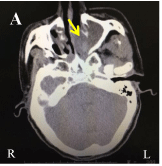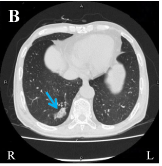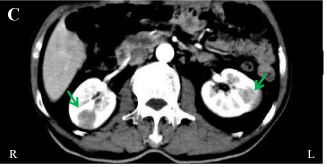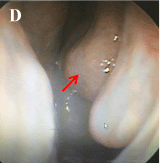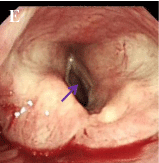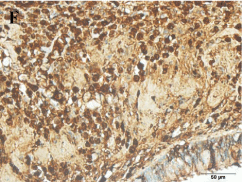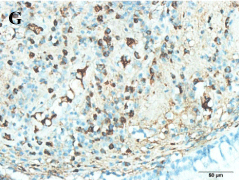Case Report
IgG4-Related Disease Mimicking Nasal Malignant Carcinoma with Multiple Organ Metastases: A Case Report
Jie-Bo Guo#, Shu-Bin Fang# and Qing-Ling Fu*
#These authors contributed equally to this manuscript
*Corresponding author: Qing-Ling Fu, Otorhinolaryngology Hospital, The First Affiliated Hospital, Sun Yat-sen University, 58 Zhongshan Road II, Guangzhou, Guangdong, 510080, P. R. China
Published: 07 Dec, 2016
Cite this article as: Guo J-B, Fang S-B, Fu Q-L. IgG4-
Related Disease Mimicking Nasal
Malignant Carcinoma with Multiple
Organ Metastases: A Case Report. Clin
Surg. 2016; 1: 1231.
Abstract
Objectives: The IgG4-related disease often mimics different malignant diseases. We presented a case of IgG4-related disease associated with lesion in nasal cavity, lung and kidney which is easily
misdiagnosed as nasal carcinoma with multiple metastases.
Method: Single case report.
Results: The patient was finally diagnosed as IgG4-related disease under the examination of IgG4 in
the nasal tissue and serum.
Conclusion: IgG4-related disease has possibility to exhibit the nasal mass accompanied by multiple
pulmonary and renal nodules which mimic malignant tumors with multiple metastases in different
organs. The doctors should attach much importance to the diagnosis of IgG4-related disease
compared to the other nasal diseases.
Keywords: IgG4; Nasal malignant carcinoma; plasmacytes
Introduction
IgG4-related disease was first reported by Hamano et al. [1] in 2001. The disease was clinically characterized by increased serum IgG4 level, infiltration of IgG4-positive plasmacytes and sclerosing lesions which generate multiple nodules in different organs [2] that it sometimes mimics malignant tumors [3-5]. To date, IgG4-related disease has been shown to be well associated with nasal diseases [6-8]. Herein, we describe a case of nasal mass with multiple organ lesions in IgG4- related disease, which is extremely easily to be misdiagnosed as malignant nasal tumor with multiple organ metastases.
Case Presentation
A 63-year-old man was admitted to our department of The First Affiliated Hospital, Sun Yat-sen
University. He had an 8-month history of impaired version in right eye and headache, and 4 month
later he underwent nasal obstruction, hoarseness and severe dysphagia which made him keep a
liquid diet. His previous CT scans revealed a mass in the left nasal cavity (Figure 1A) and multiple
nodules in bilateral lung (Figure 1B) and kidney (Figure 1C). Previous nasal endoscopy also showed a left-side nasal neoplasm (Figure 1D) and vocal cord paralysis (Figure 1E). The patient was referred to several different hospitals and the nasal mass was mostly considered to be a nasal tumor with
multiple metastases. However, percutaneous renal biopsies were performed and no malignant
lesion was detected. The patient further underwent a nasal endoscopic surgery for antrostomy on left
sinus and resection of left-side nasal neoplasm in Yangjiang Central Hospital, China. Surprisingly,
the postoperative pathology revealed the nasal polyp on the left nasal sinus and chronic mucosal
inflammation on rhino-pharynx. However, the patient didn’t have any relieves from the symptoms
of headache and decreased vision after the surgery. Then the patient came to our department for
further diagnosis and treatment. The patients received both the computed tomography and magnetic
resonance imaging in our hospital and they indicated diffuse inflammation in the pterygoid muscle,
optic sheath, cerebellopontine area and cavernous sinus region.
From the above findings of his history and examinations, autoimmune diseases especially the
IgG4 related disease were highly considered. Thus, further biopsy was performed from the nasal
mass. The immunohistochemical examination indicated that there were many IgG (Figure 1F) and
IgG4 (Figure 1G) positive cells in the nasal mass and the ratio of IgG4 and total IgG positive cells
is more than 40% (Figure 1F-1G). Moreover, serum IgG4 was also
measured and was found to increase to 21.10 g/L (The level of serum
IgG4 more than 1.35 g/L is considered to be positive). The patient
was finally diagnosed as IgG4-related disease after excluding some
other possible diseases such as the lymphoma and nasopharyngeal
carcinoma. After the systemic administration of steroid, the patient
had a quick recovery.
Figure 1
Figure 1
Pictures from a patient of IgG4-related disease.
A: CT images of nasal mass (yellow arrow).
Figure 1B
Figure 1C
Figure 1D
Figure 1E
Figure 1E
The paralysis of the left vocal cord (purple arrow) can also be
found under the endoscopy.
Figure 1F
Figure 1F
The immunohistochemistry for the nasal tissue have shown the IgG-positive cell infiltration (400X).
Figure 1G
Discussion
The IgG4-related disease has been described as a novel clinical
entity [2] which is defined by diffuse or localized swelling or masses
in single or multiple organs, high serum IgG4 level and infiltration
of IgG4-positive plasmacytes in the target tissues [9]. The patient in
our case was diagnosed definitely as IgG4-related disease based on
the diagnostic criteria. Except for the nasal mass and pulmonary and
renal nodules, the inflammation in the skull base and the complained
of hoarseness and severe dysphagia should also be parts of the
manifestations of IgG4-related disease.
In our case, the patient was found to have a nasal mass
accompanied by multiple nodules in lung and kidney, which was
highly suspected of malignant nasal carcinoma with multiple organ
metastases. Though para-nasal lesion in IgG4-related disease that
mimicking nasopharyngeal carcinoma has been reported since the
year of 2010 [6,8], our case was the first one that exhibited the nasal
mass accompanied by multiple organ nodules in IgG4-related disease,
making it much more confusing to diagnose the disease simply based
on the chief complaints and the auxiliary examinations if the serum
level of IgG4 and immunochemistry examination for IgG4 in the
nasal mass were not performed.
Before the final diagnosis of IgG4-related disease in our hospital,
the patient already underwent an endoscopic surgery for the
resection of nasal mass in local hospital but has no any relieves from
his complaints. However, he quickly recovered from the disease after
the steroid was administrated systemically. It should be noted that
the nasal mass in IgG4-related disease could become small with the
treatment of steroid and an endoscopic surgery should be avoided.
Therefore, we should strengthen our understanding and awareness
for the diagnosis of the IgG4-related disease in nasal disease.
Acknowledgment
This study was supported by grants from National Science Foundation of Guangdong Province (2016A030308017) and the Fundamental Research Funds for the Central Universities (15ykcj11c).
References
- Hamano H, Kawa S, Horiuchi A, Unno H, Furuya N, Akamatsu T, et al. High serum IgG4 concentrations in patients with sclerosing pancreatitis. N Engl J Med. 2001; 344: 732-738.
- Kamisawa T, Zen Y, Pillai S, Stone JH. IgG4-related disease. Lancet. 2015; 385: 1460-1471.
- Inoue T, Okumura F, Mizushima T, Nishie H, Iwasaki H, Anbe K, et al. Localized IgG4-related Cholecystitis Mimicking Gallbladder Cancer. Intern Med. 2015; 54: 1869-1874.
- Wang Y, Chen X, Luo R, Wang H, Wang G, Hou Y, et al. IgG4-related systemic disease mimicking renal pelvic cancer: a rare case. World J Surg Oncol. 2014; 12: 395.
- Nakazawa S, Shimizu K, Nakano T, Kakegawa S, Atsumi J, Kamiyoshihara M, et al. An immunoglobulin G4-related disease mimicking postoperative lung cancer recurrence. Mod Rheumatol. 2012; 22: 787-790.
- Liu J, Zhang B, Sun H, Han J, Yang D. Immunoglobulin G4-related disease in the skull base mimicking nasopharyngeal carcinoma. J Craniofac Surg. 2015; 26: e144-e145.
- Moteki H, Yasuo M, Hamano H, Uehara T, Usami S. IgG4-related chronic rhinosinusitis: a new clinical entity of nasal disease. Acta Otolaryngol. 2011; 131: 518-526.
- Pace C, Ward S. A rare case of IgG4-related sclerosing disease of the maxillary sinus associated with bone destruction. J Oral Maxillofac Surg. 2010; 68: 2591-2593.
- Umehara H, Okazaki K, Masaki Y, Kawano M, Yamamoto M, Saeki T, et al. Comprehensive diagnostic criteria for IgG4-related disease (IgG4-RD), 2011. Mod Rheumatol. 2012; 22: 21-30.

